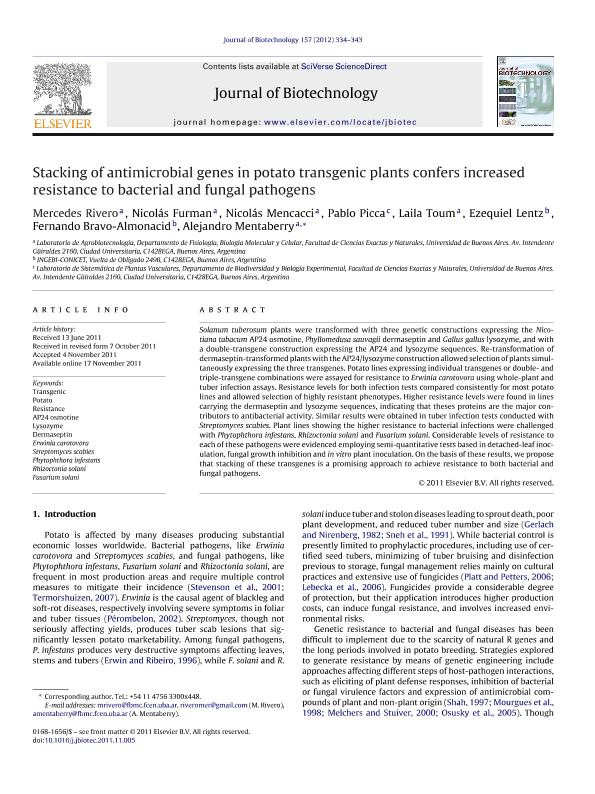Mostrar el registro sencillo del ítem
dc.contributor.author
Rivero, Mercedes
dc.contributor.author
Furman, Nicolas

dc.contributor.author
Mencacci, Nicolas

dc.contributor.author
Picca, Pablo Ignacio

dc.contributor.author
Toum, Laila

dc.contributor.author
Lentz, Ezequiel Matias

dc.contributor.author
Bravo Almonacid, Fernando Felix

dc.contributor.author
Mentaberry, Alejandro Nestor

dc.date.available
2019-07-11T20:21:44Z
dc.date.issued
2012-01
dc.identifier.citation
Rivero, Mercedes; Furman, Nicolas; Mencacci, Nicolas; Picca, Pablo Ignacio; Toum, Laila; et al.; Stacking of antimicrobial genes in potato transgenic plants confers increased resistance to bacterial and fungal pathogens; Elsevier Science; Journal of Biotechnology; 157; 2; 1-2012; 334-343
dc.identifier.issn
0168-1656
dc.identifier.uri
http://hdl.handle.net/11336/79418
dc.description.abstract
Solanum tuberosum plants were transformed with three genetic constructions expressing the Nicotiana tabacum AP24 osmotine, Phyllomedusa sauvagii dermaseptin and Gallus gallus lysozyme, and with a double-transgene construction expressing the AP24 and lysozyme sequences. Re-transformation of dermaseptin-transformed plants with the AP24/lysozyme construction allowed selection of plants simultaneously expressing the three transgenes. Potato lines expressing individual transgenes or double- and triple-transgene combinations were assayed for resistance to Erwinia carotovora using whole-plant and tuber infection assays. Resistance levels for both infection tests compared consistently for most potato lines and allowed selection of highly resistant phenotypes. Higher resistance levels were found in lines carrying the dermaseptin and lysozyme sequences, indicating that theses proteins are the major contributors to antibacterial activity. Similar results were obtained in tuber infection tests conducted with Streptomyces scabies. Plant lines showing the higher resistance to bacterial infections were challenged with Phytophthora infestans, Rhizoctonia solani and Fusarium solani. Considerable levels of resistance to each of these pathogens were evidenced employing semi-quantitative tests based in detached-leaf inoculation, fungal growth inhibition and in vitro plant inoculation. On the basis of these results, we propose that stacking of these transgenes is a promising approach to achieve resistance to both bacterial and fungal pathogens.
dc.format
application/pdf
dc.language.iso
eng
dc.publisher
Elsevier Science

dc.rights
info:eu-repo/semantics/openAccess
dc.rights.uri
https://creativecommons.org/licenses/by-nc-sa/2.5/ar/
dc.subject
AP24 OSMOTINE
dc.subject
DERMASEPTIN
dc.subject
ERWINIA CAROTOVORA
dc.subject
FUSARIUM SOLANI
dc.subject
LYSOZYME
dc.subject
PHYTOPHTHORA INFESTANS
dc.subject
POTATO
dc.subject
RESISTANCE
dc.subject
RHIZOCTONIA SOLANI
dc.subject
STREPTOMYCES SCABIES
dc.subject
TRANSGENIC
dc.subject.classification
Bioquímica y Biología Molecular

dc.subject.classification
Ciencias Biológicas

dc.subject.classification
CIENCIAS NATURALES Y EXACTAS

dc.title
Stacking of antimicrobial genes in potato transgenic plants confers increased resistance to bacterial and fungal pathogens
dc.type
info:eu-repo/semantics/article
dc.type
info:ar-repo/semantics/artículo
dc.type
info:eu-repo/semantics/publishedVersion
dc.date.updated
2019-07-10T19:04:02Z
dc.journal.volume
157
dc.journal.number
2
dc.journal.pagination
334-343
dc.journal.pais
Países Bajos

dc.journal.ciudad
Amsterdam
dc.description.fil
Fil: Rivero, Mercedes. Universidad de Buenos Aires. Facultad de Ciencias Exactas y Naturales. Departamento de Fisiología, Biología Molecular y Celular; Argentina
dc.description.fil
Fil: Furman, Nicolas. Consejo Nacional de Investigaciones Científicas y Técnicas; Argentina. Universidad de Buenos Aires. Facultad de Ciencias Exactas y Naturales. Departamento de Fisiología, Biología Molecular y Celular; Argentina
dc.description.fil
Fil: Mencacci, Nicolas. Universidad de Buenos Aires. Facultad de Ciencias Exactas y Naturales. Departamento de Fisiología, Biología Molecular y Celular; Argentina
dc.description.fil
Fil: Picca, Pablo Ignacio. Universidad de Buenos Aires. Facultad de Ciencias Exactas y Naturales. Departamento de Biodiversidad y Biología Experimental. Laboratorio del Grupo de Estudio de Plantas Vasculares; Argentina
dc.description.fil
Fil: Toum, Laila. Consejo Nacional de Investigaciones Científicas y Técnicas; Argentina. Universidad de Buenos Aires. Facultad de Ciencias Exactas y Naturales. Departamento de Fisiología, Biología Molecular y Celular; Argentina
dc.description.fil
Fil: Lentz, Ezequiel Matias. Consejo Nacional de Investigaciones Científicas y Técnicas. Instituto de Investigaciones en Ingeniería Genética y Biología Molecular "Dr. Héctor N. Torres"; Argentina
dc.description.fil
Fil: Bravo Almonacid, Fernando Felix. Consejo Nacional de Investigaciones Científicas y Técnicas. Instituto de Investigaciones en Ingeniería Genética y Biología Molecular "Dr. Héctor N. Torres"; Argentina
dc.description.fil
Fil: Mentaberry, Alejandro Nestor. Consejo Nacional de Investigaciones Científicas y Técnicas; Argentina. Universidad de Buenos Aires. Facultad de Ciencias Exactas y Naturales. Departamento de Fisiología, Biología Molecular y Celular; Argentina
dc.journal.title
Journal of Biotechnology

dc.relation.alternativeid
info:eu-repo/semantics/altIdentifier/doi/https://doi.org/10.1016/j.jbiotec.2011.11.005
dc.relation.alternativeid
info:eu-repo/semantics/altIdentifier/url/https://www.sciencedirect.com/science/article/pii/S0168165611006390
Archivos asociados
